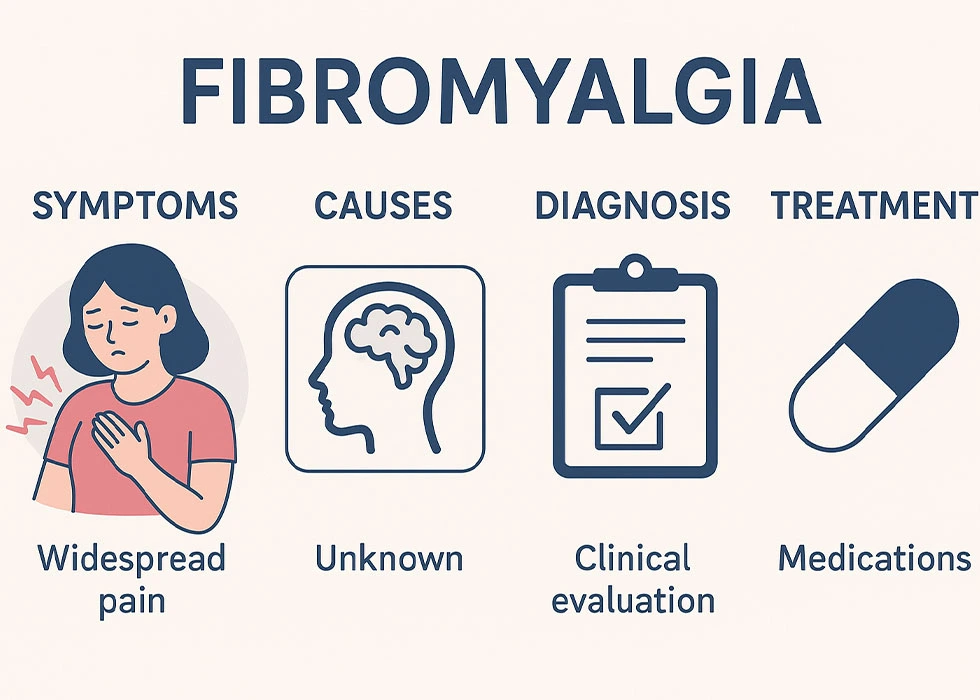
Fibromyalgia: Symptoms, Causes, Diagnosis, and Treatment
- August 15, 2025
- 1 Like
- 34 Views
- 0 Comments
Fibromyalgia symptoms is a long-term (chronic) health condition that causes widespread musculoskeletal pain, fatigue, and problems with sleep, memory, and mood. Researchers believe it affects how the brain and spinal cord process pain and non-pain signals, increasing overall pain sensitivity.
The condition can develop after a triggering event — such as injury, surgery, infection, or significant emotional stress — or gradually over time without a single cause. While it can affect anyone, it is more common in women and often appears in middle age, though it can also occur in children.
According to U.S. statistics, around 4 million adults (2% of the population) live with fibromyalgia. The condition is real, and symptoms can be life-impacting, but a combination of treatments can help manage them.
Common Symptoms
Fibromyalgia symptoms vary but often include:
Physical symptoms
- Widespread pain: A constant dull ache lasting at least three months, affecting both sides of the body above and below the waist.
- Tenderness in muscles, joints, and soft tissues.
- Fatigue: Feeling tired even after long sleep, often worsened by pain-related sleep disruption.
- Headaches or migraines
- Jaw and facial pain (TMJ disorders)
- Digestive issues: Irritable bowel syndrome (IBS), constipation, or diarrhea.
- Bladder problems: Including urgency and interstitial cystitis.
- Muscle stiffness and heaviness in limbs.
Cognitive and emotional symptoms
- Fibro fog: Difficulty focusing, remembering information, or staying alert.
- Anxiety and depression
- Sleep disorders: Insomnia, restless legs syndrome, and sleep apnea.
Other possible symptoms
- Dry eyes
- Skin rashes or itching
- Lower abdominal discomfort
- Increased sensitivity to temperature changes
How Fibromyalgia Pain Feels
The pain can range from mild achiness to intense, debilitating discomfort. It may present as:
- Sharp or stabbing (especially in the chest)
- Burning or throbbing (common in legs)
- Deep muscular ache
- Tingling or numbness in limbs
Pain can occur in multiple body regions, including the back, chest, shoulders, hips, and knees, often overlapping with areas once called “tender points.”
Causes and Risk Factors
The exact cause of fibromyalgia is unknown, but research suggests a combination of genetic, neurological, and environmental factors.
Possible causes include:
- Nervous system changes: Overactive pain processing and altered brain chemicals (neurotransmitters).
- Genetics: Family history increases susceptibility.
- Infections: Illnesses like flu, pneumonia, Epstein-Barr virus, or certain gut infections may trigger symptoms.
- Physical or emotional trauma: Accidents, surgeries, or significant stress events.
- Hormonal changes: Especially during menopause.
Risk factors:
- Female sex
- Age over 40
- Family history of fibromyalgia
- Coexisting conditions such as arthritis, lupus, or chronic fatigue syndrome
- Chronic stress or PTSD
Fibromyalgia Flare-Up Triggers
Flare-ups may be triggered by:
- Emotional stress
- Weather or temperature changes
- Poor sleep or changes in sleep schedule
- Illness or infection
- Hormonal shifts
- Changes in diet or nutrition
- Altered medication routines
Diagnosis
There is no single test for fibromyalgia. Diagnosis involves:
- Medical history and symptom review
- Physical examination
- Excluding other conditions via blood tests (e.g., thyroid disorders, anemia) or imaging
- Current diagnostic criteria: Pain in at least 4 of 5 defined body regions for 3+ months, plus associated symptoms such as fatigue and cognitive difficulties
Older “tender point” tests are largely replaced by widespread pain index and symptom severity scales.
Treatment and Management
Treatment focuses on symptom control and improving quality of life. There is no cure, but many people find relief through a combination of methods:
Medications
- Pain relievers: Acetaminophen, ibuprofen, naproxen
- Antidepressants: Duloxetine (Cymbalta), milnacipran (Savella) — to improve pain, mood, and sleep
- Antiseizure drugs: Pregabalin (Lyrica), gabapentin (Neurontin) — to reduce nerve pain
- Sleep aids (short-term use for insomnia)
Therapies
- Cognitive Behavioral Therapy (CBT) for stress and mood management
- Physical therapy to improve mobility and reduce stiffness
- Occupational therapy to adapt daily routines
Lifestyle changes
- Regular low-impact exercise (walking, swimming, tai chi, gentle yoga)
- Healthy, balanced diet
- Consistent sleep schedule
- Relaxation techniques (meditation, breathing exercises, mindfulness)
Natural and alternative remedies
- Acupuncture
- Massage therapy
- Stress-reduction programs
- Nutritional supplements (discuss with a healthcare provider)
Outlook and Living with Fibromyalgia
Fibromyalgia is a chronic condition, but symptoms can improve over time with the right approach. Many patients experience:
- Fewer flare-ups
- Better sleep
- Improved daily functioning
Tips for living well with fibromyalgia:
- Build a strong support network
- Track triggers and avoid them when possible
- Be patient with treatment adjustments
- Seek mental health support when needed
Key Takeaways
- Fibromyalgia is real and affects millions worldwide.
- Symptoms include widespread pain, fatigue, sleep issues, and cognitive problems.
- No cure exists, but symptoms can be managed through medication, therapy, and lifestyle changes.
- Early diagnosis and personalized care improve long-term outcomes.


Leave Your Comment